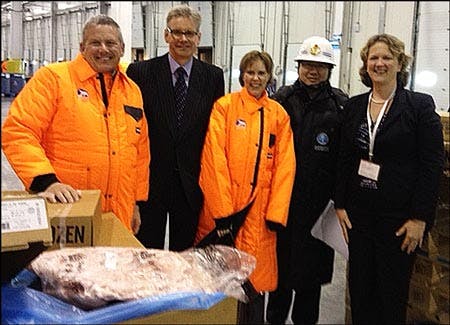Agricultural Trade Delegations Focus on China
Published: Apr 04, 2012
The USDA’s largest overseas agricultural trade mission to date took place last week, and USMEF accompanied more than 40 U.S. companies to Chengdu, Sichuan Province, and Shanghai in China to explore trade opportunities for U.S. red meat exports.

Led by Acting Undersecretary for Farm and Foreign Agricultural Services Michael Scuse, the delegation included agricultural leaders from six state departments of agriculture, including Iowa Agriculture Secretary Bill Northey, Oklahoma Agriculture Secretary Jim Reese and representatives from North Carolina, Illinois, Kansas and South Dakota.
Joel Haggard, USMEF’s senior vice president for the Asia-Pacific region, and Jianwen Liu, China director of government affairs and regulatory analysis, joined the group for visits to Shanghai port's inspection and quarantine leadership (CIQ), and for retail visits to senior managers at Metro, a leading cash and carry retail operator in China that focuses on the foodservice trade. Haggard and Liu also participated in agricultural briefings and panels with leading local agricultural and food stakeholders.
Deputy Undersecretary for Farm and Foreign Agricultural Services Darci Vetter and Chief Agricultural Negotiator Ambassador Islam Siddiqui also joined the group in Shanghai.
The Shanghai portion of the visit began with a “natural” American pork chop dinner at the iconic Shanghai Bund restaurant, House of Roosevelt. Highlights of the trade delegation included a visit to Shanghai's new Yangshan container port and to USMEF member Preferred Freezer's new state-of-the-art facility in the Lingang area of the city. Haggard also discussed meat trade opportunities with senior buyers at Metro, which operates 54 stores nationwide and is known for its exemplary merchandising of chilled meat.
“Challenges remain for entry into Metro and other modern retailers in China due to the continued ban on U.S. beef imports and the difficulty of importing sizable volumes of chilled pork by sea,” said Haggard. "We stated our desire to Shanghai CIQ to work with them to develop an expeditious protocol for inspecting time-sensitive chilled pork, but the realization of a protocol similar to the rapid inspection and clearance regimes in place in South Korea and Japan, our other principal North Asian chilled markets, will take more time."
Later in the week, Haggard and USMEF-Shanghai hosted more than 30 representatives of the Minnesota Soybean Research and Promotion Council. The group observed diverse retailing concepts for meat products, including U.S. products, at a local wholesale market and a Carrefour store. The group completes its joint soybean-red meat study tour this week. Minnesota Soybean farmers are supporting USMEF pork marketing efforts in China this year with funding for retail and chef development projects.
Bilateral agricultural trade between the United States and China in fiscal year 2011 reached an all-time high of $32.1 billion. Of that, U.S. exports to China accounted for $22.8 billion. China has become the USDA’s largest overseas presence. With seven offices in five cities, the USDA provides critical support in areas where USMEF has no presence.
The U.S. exported $713 million of U.S. pork products to China last year, a new record, and exports in January reached $75.1 million, a 158 percent jump over last year. However, USMEF’s Jianwen Liu is more cautious about this year's prospects.
"Live hog, piglet and pork prices are falling in China, but continued industry profitability is still driving an expansion in capacity,” said Liu. “We see lower import demand this year, especially if major disease outbreaks can be contained."
